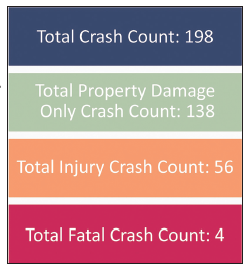Kane County crash and injury statistics provided by Utah Department of Public Safety
- Ty Gant

- Nov 1, 2023
- 3 min read
Last week’s edition of the Southern Utah News had a report on safety practices for driving, as provided by the Utah Department of Transportation (UDOT), Utah Highway Patrol (UHP) and Utah Department of Public Safety (DPS), as well as a promise for a follow-up with more local statistics and safety recommendations. Here are some of those statistics, as well as commentary from local authorities.
According to the data specific to Kane County, 2023 already has double the amount of injuries as a result of vehicle crashes as of October 30 - a number that is cause for some concern going into a potentially snowy season. Additionally, 2023 has already matched Kane County’s 2022 total fatalities and surpassed the count in total injuries, indicating a spike in the first three quarters of the year. Authorities are urging drivers to keep best safety practices in mind, especially as the colder season sets in and road conditions have the potential to become icy.
When asked for his perspective on what was causing the increase in crash numbers and severity, Chief Tom Cram of the Kanab Police Department replied, “Speed is the main factor in Kanab. Take the Kanab City Ranchos for example: if someone from the north side of town near [Jacob Hamblin Park] were taking their kid to the elementary school, speeding 15 miles per hour faster than the speed limit, getting there would save them around 30 seconds of trip time, but it makes crashes more likely and more dangerous. I’ve spoken with Highway Patrol, they say people getting over 100 miles an hour on the highways are more common, and usually those people are only saving a few minutes off their trip.”
Being a rural area, Kane County’s crashes are also dramatically more likely to be caused by wild animal encounters - numbers echoed by northern Coconino and Mojave counties. Deer impacts and collisions as a result of swerving or sudden breaking due to an animal on the road are real risks in our area. Authorities recommend extra caution when traveling in the twilight hours, when visibility can be low and animals like deer are more active. Additionally, driving due east in the morning and due west in the evening can impair visibility thanks to the sun being straight ahead; if such travel is necessary, mitigate the risks by driving carefully, wearing sunglasses and appropriately positioning the vehicle’s sun visors.
The data also cites “holiday related travel” as one of the prevalent causes of collisions compared to other parts of Utah and Arizona. Not only do holidays increase the density of travelers on the roads, but they also increase the numbers of drivers unfamiliar with driving in the local area. Drivers are encouraged to be informed of days off and high-density traveling days in these areas frequented by visitors. Kane County Sheriff Tracy Glover said of the issue, “Visitation, and therefore traffic, between [State Route 20] and Kanab has increased sharply over the past 10 years. UDOT has been trying to increase passing lane distances but the increase in traffic has caused a lot of frustration with motorists. We will continue to push for more passing lanes but in the meantime, drivers are going to have to leave earlier, take a deep breath and expect slower traffic.”
As 2023 enters its colder season, traffic authorities are hoping to see traffic incidents, especially those resulting in injury or death, level out as drivers take the previous spike as a caution. Traffic incidents in Kane County are mostly rated “No Injury/Property Damage Only,” meaning in a majority of accidents, the individuals involved walk away unharmed. As mentioned last week, Utah and Arizona are generally safer to travel than other more densely populated states in the US, and traffic authorities urge citizens to continue to improve that trend by driving safely.








